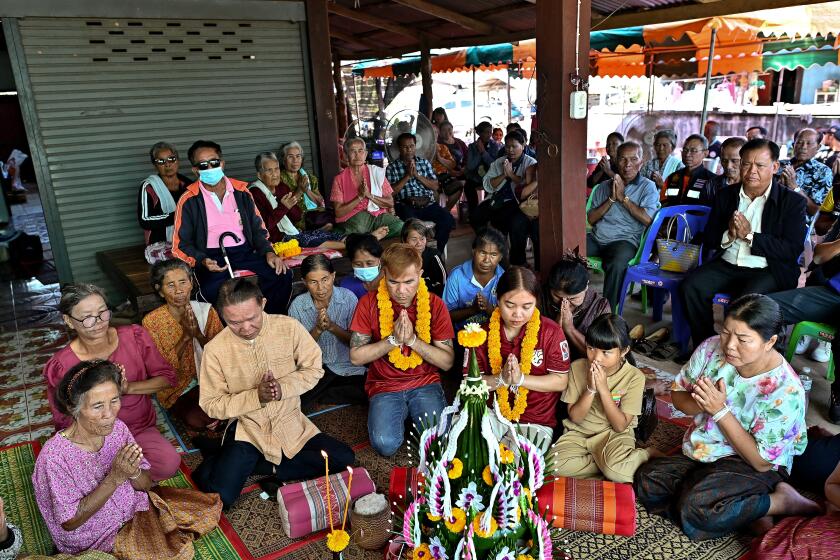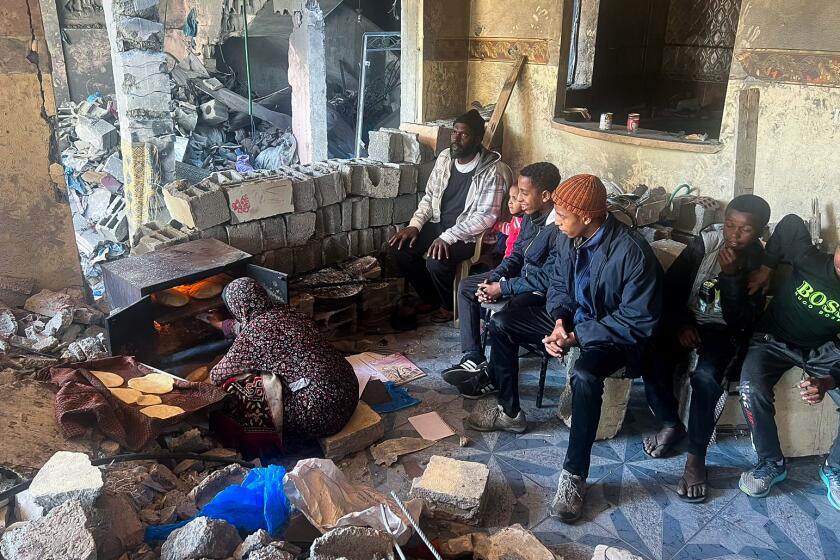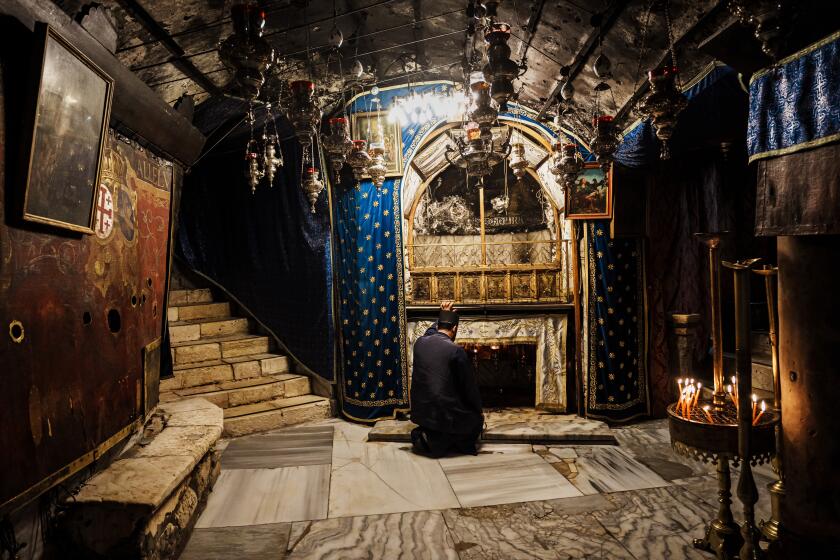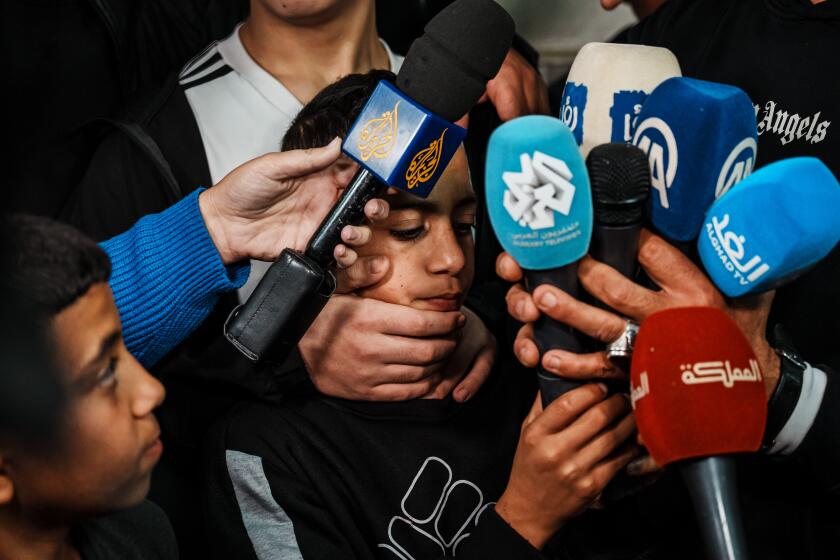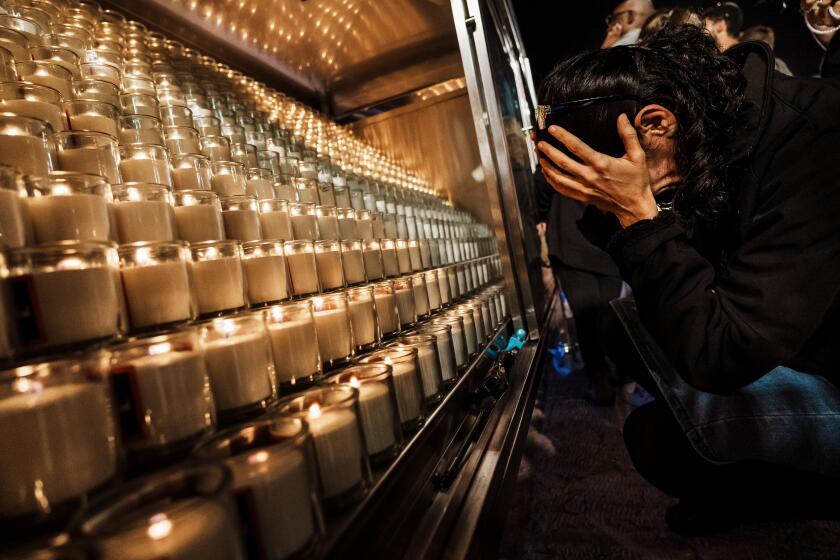Israel says it finds Hamas command center in Gaza City as cease-fire talks gain momentum
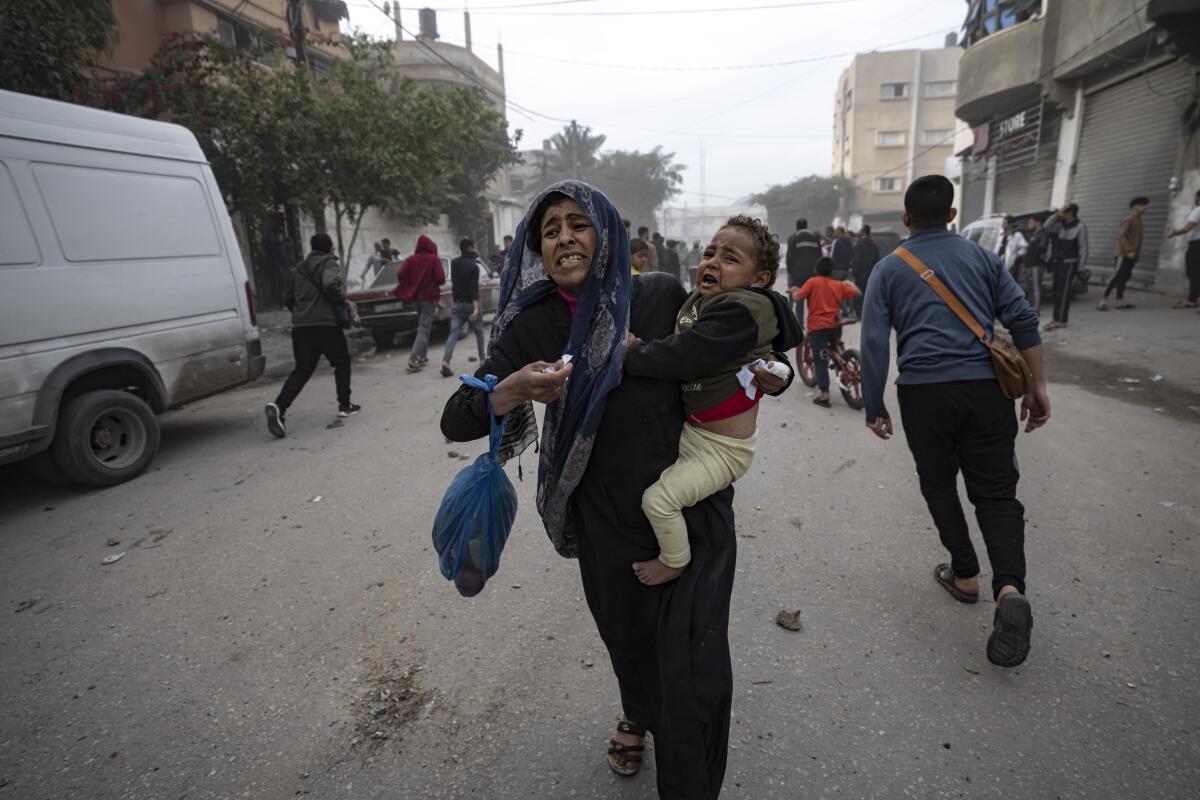
- Share via
JERUSALEM — The Israeli military said Wednesday that it had uncovered a major Hamas command center in the heart of Gaza City, inflicting what it described as a serious blow to the Islamic militant group as pressure grows on Israel to scale back its devastating attacks in the Gaza Strip.
The army said it had exposed the center of a vast underground network used by Hamas to move weapons, militants and supplies throughout the coastal enclave. Israel has said destroying the tunnels is a major objective of its war in Gaza.
The announcement came as Hamas’ top leader arrived in Egypt for talks aimed at brokering a temporary cease-fire and a new deal for Hamas to swap Israeli hostages for Palestinians imprisoned by Israel.
Israel’s leaders have vowed to press ahead with its offensive, launched in response to a cross-border attack by Hamas on Oct. 7 that killed at least 1,200 people and saw 240 others taken hostage.
Israel’s airstrikes and ground attacks have devastated much of the northern Gaza Strip, killed about 20,000 Palestinians and driven some 1.9 million — nearly 85% of the population — from their homes. The widespread destruction and heavy civilian death toll have drawn increasing international calls for a cease-fire.
The United States, Israel’s closest ally, has continued its support while urging greater effort to protect Gaza’s civilians.
For a Thai farmworker taken hostage by Hamas militants Oct. 7, memories of Israel and Gaza are of love, grief and heartbreak for those she left behind.
But in some of the toughest American language yet, Secretary of State Antony J. Blinken on Wednesday called on Israel to scale back its operation.
“It’s clear that the conflict will move and needs to move to a lower-intensity phase,” Blinken said. He said the U.S. wants to see “more targeted operations” with smaller levels of forces focused on specific targets, such as Hamas’ leaders and the group’s tunnel network.
“As that happens, I think you’ll see as well the harm done to civilians also decrease significantly,” he said.
His comments were more pointed than statements by Defense Secretary Lloyd J. Austin III, who in a visit to Israel this week said the U.S. would not dictate any time frames to its ally.
‘I just don’t know where we’ll go.’ It’s a question Palestinians ask over and over in Gaza as Israel ramps up bombardment after Hamas truce collapsed.
Israel says it finds tunnel complex
The Israeli military escorted Israeli reporters into Palestine Square in the heart of Gaza City to show off what it described as the center of Hamas’ tunnel network.
Military commanders boasted that they had uncovered offices, tunnels and elevators used by Hamas’ top leaders. The military released videos of underground offices and claimed to have found a wheelchair belonging to Hamas’ shadowy military commander, Mohammed Deif, who has not been seen in public in years.
The army’s chief spokesman, Rear Adm. Daniel Hagari, said the army had found a vast underground complex. “They all used this infrastructure routinely, during emergencies and also at the beginning of the war on Oct. 7,” he said. He said the tunnels stretched across Gaza and into major hospitals.
The claims could not be independently verified.
Hagari also indicated that Israel was winding down in northern Gaza, including Gaza City, where it has been battling Hamas militants for weeks. He said the army had moved into a final remaining Hamas stronghold, the Gaza City neighborhood of Tufah.
In Bethlehem, the West Bank town revered as Jesus’ birthplace, Christmas is all but canceled, in solidarity with Palestinians’ suffering in Gaza.
But the army also acknowledged a significant misstep. An investigation into its soldiers’ mistaken shooting of three Israeli hostages in Gaza found that, five days before the shooting, a military search dog with a body camera had captured audio of them shouting for help in Hebrew.
Hagari said the recording was not reviewed until after the hostages were killed while trying to make themselves known to Israeli forces.
The incident has sparked an uproar in Israel and put pressure on the government to reach a new deal with Hamas. The military chief has said the shooting was against its rules of engagement.
The Israeli military campaign now is largely focused on southern Gaza, where it says Hamas’ leaders are hiding.
“We will continue the war until the end. It will continue until Hamas is destroyed, until victory,” Israeli Prime Minister Benjamin Netanyahu said in a video statement. “Whoever thinks we will stop is detached from reality.”
Cease-fire talks gain momentum
As Netanyahu vowed to continue the war, there were new signs of progress in cease-fire talks.
Hamas’ top leader, Ismail Haniyeh, traveled to Cairo for talks on the war, part of a flurry of diplomacy. In recent days, top Israeli, American and Qatari officials have also held cease-fire talks.
“These are very serious discussions and negotiations, and we hope that they lead somewhere,” the White House’s National Security Council spokesman, John F. Kirby, said aboard Air Force One while traveling with President Biden to Wisconsin.
Biden, however, indicated a deal was still a ways off. “There’s no expectation at this point, but we are pushing,” he said. Asked about the rising death toll in Gaza, Biden said: It’s tragic.”
Hamas says no more hostages will be released until the war ends. It is insisting on the release of large numbers of Palestinian prisoners, including high-level militants convicted in deadly attacks, for remaining captives.
Osama Hamdan, a senior Hamas official in Beirut, said the efforts right now are focused on how to “stop this aggression, especially that our enemy now knows that it cannot achieve any of its goals.”
The recent hostage-for-prisoner swaps between Hamas and Israel have focused attention on the number of Palestinian minors imprisoned by Israel.
Israel has rejected Hamas’ demands for a mass prisoner release. But it has a history of lopsided exchanges for captive Israelis, and the government is under heavy public pressure to bring the hostages home safely.
Egypt, along with Qatar and the U.S., helped mediate a weeklong cease-fire in November in which Hamas freed more than 100 hostages in exchange for Israel’s release of 240 imprisoned Palestinians. Hamas and other militants are still holding an estimated 129 captives, though about 20 are believed to have died in captivity.
United Nations Security Council members are negotiating an Arab-sponsored resolution to halt the fighting in some way to allow for an increase in desperately needed humanitarian aid deliveries to Gaza.
A vote on the resolution, first scheduled for Monday, was pushed back again Wednesday in the hopes of getting the U.S. to support it or allow it to pass after it vetoed an earlier cease-fire call.
Humanitarian crisis
Cellphone and internet service was down across Gaza again Wednesday, an outage that could complicate efforts to communicate with Hamas’ leaders in the territory who went into hiding after Oct. 7.
The war has led to a humanitarian crisis in Gaza. Tens of thousands of people are crammed into shelters and tent camps amid shortages of food, medicine and other basic supplies. Israel’s foreign minister traveled to Cyprus to discuss the possibility of establishing a maritime corridor that would allow the delivery of large amounts of humanitarian aid to Gaza.
‘Who will we be when we rise from the ashes and reenter our lives?’ Israeli novelists, filmmakers and TV writers are wondering how to tell the story of the Oct. 7 attacks and the war that followed
At least 46 people were killed and more than 100 wounded early Wednesday as Israel continued to bombard the urban Jabaliya refugee camp near Gaza City, said Munir Boursh, a senior Health Ministry official.
In southern Gaza, several women and children were among those brought into Nasser Hospital in the city of Khan Yunis after strikes overnight and into Wednesday. A boy could be seen sobbing next to his wounded mother, who was laid out on a stretcher, before being lifted up and placed on her chest.
At least five people were killed and dozens injured in another strike that hit three homes and a mosque in the southern city of Rafah on Wednesday, health officials said.
The Health Ministry in Hamas-run Gaza said the death toll since the start of the war had risen to more than 20,000. It does not distinguish between civilian and combatant deaths.
Israel’s military says 134 of its soldiers have been killed in the Gaza ground offensive. Israel says it has killed some 7,000 militants, without providing evidence, and blames civilian deaths on Hamas, saying it uses them as human shields.
Shurafa and Magdy reported from Deir al Balah, Gaza Strip; and Cairo, respectively. AP writers Melanie Lidman in Tel Aviv, Bassem Mroue in Beirut and Aamer Madhani aboard Air Force One contributed to this report.
More to Read
Sign up for Essential California
The most important California stories and recommendations in your inbox every morning.
You may occasionally receive promotional content from the Los Angeles Times.
